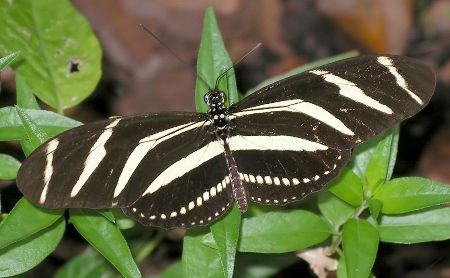by Valerie
January, 2004Zebra Longwing Butterfly Although Austin is officially in Plant Hardiness Zone 8, which means our winter temperature can get down below 20°F, we are close to the border of the more tropical Gulf coast climate. Because of this, we often grow plants from both areas and insect visitors may stray down from the central plains or up from the coast. I am generally more enamored with the tropical insects as they seem so much more exotic than those from the temperate north. This is certainly the case with the zebra longwing butterfly (Heliconius charitonius). While not particularly colorful, the bold stripes of this butterfly make it unmistakable. In some populations, the stripes are more yellow, but the individuals I've seen around here have nearly white markings. The genus Heliconius is largely confined to tropical America, with only a small number of species straying as far north as the United States. Zebra longwings are very common in Florida (where they are the official state butterfly) and near the Gulf coast. Here, they show up every summer, but not in great numbers. The caterpillars feed on passionflower vines, and our native species are the attraction. The insects cannot tolerate freezing temperatures at any stage in their life, so their migration to our area happens on a seasonal basis. While I occasionally find the black and white caterpillars on passionflower vines, more often only the adult butterflies are evident. Their slow, languid flight is captivating, and they seem to merely drift along like feathers on a light breeze. They can, however, fly more quickly when the need arises. Zebra longwings have rather long adult life spans compared to many species, living for around four months. The chemicals ingested by the caterpillars supposedly give the adult butterflies a repulsive taste and they are rarely attacked by birds. While I have never tasted one to be sure, it is true that I cannot recall ever seeing a zebra longwing that has a nip out of its wing from a bird attack, as many other species of butterflies often do. |
(Heliconids is an article on "larvalbug's garden" which provides more photos and information on the zebra longwing and related Gulf fritillary.)